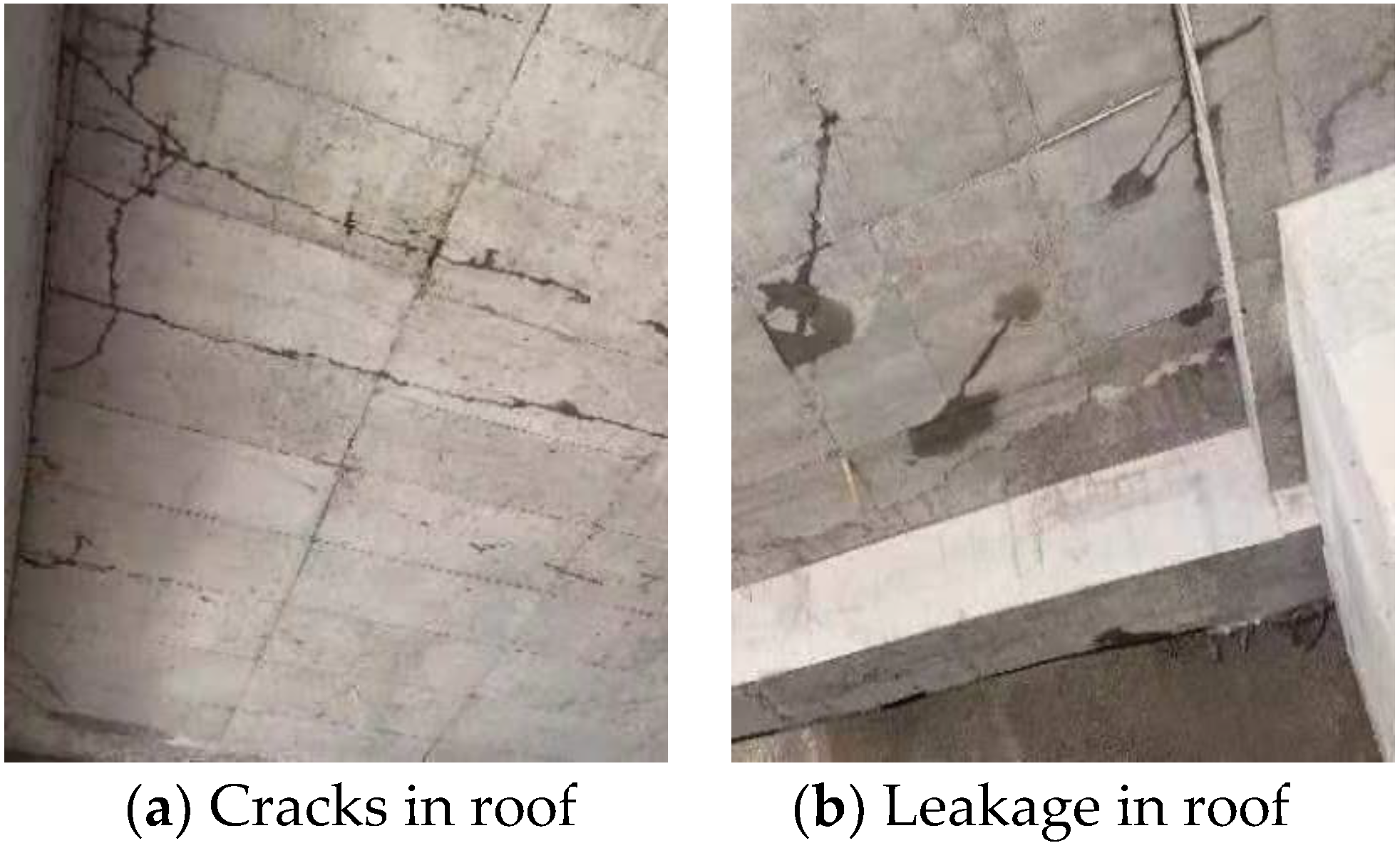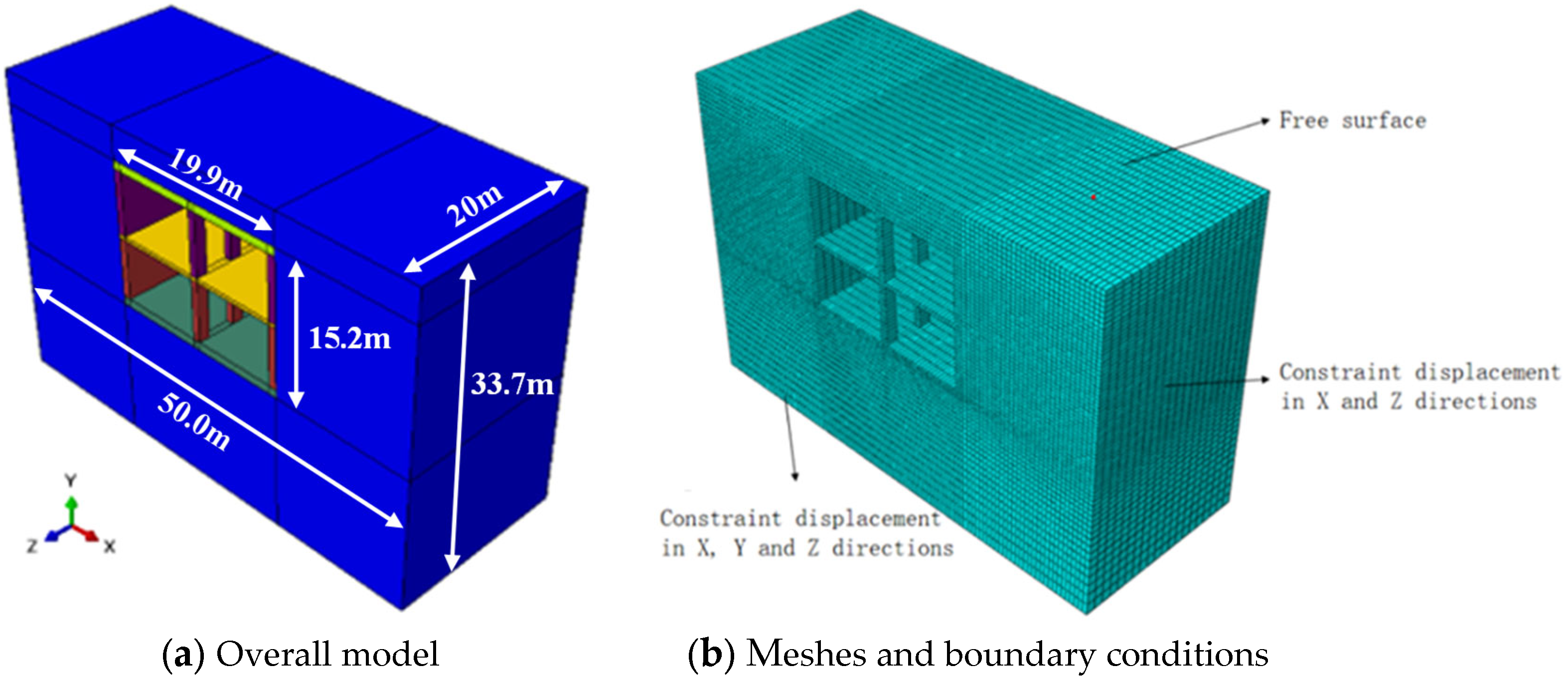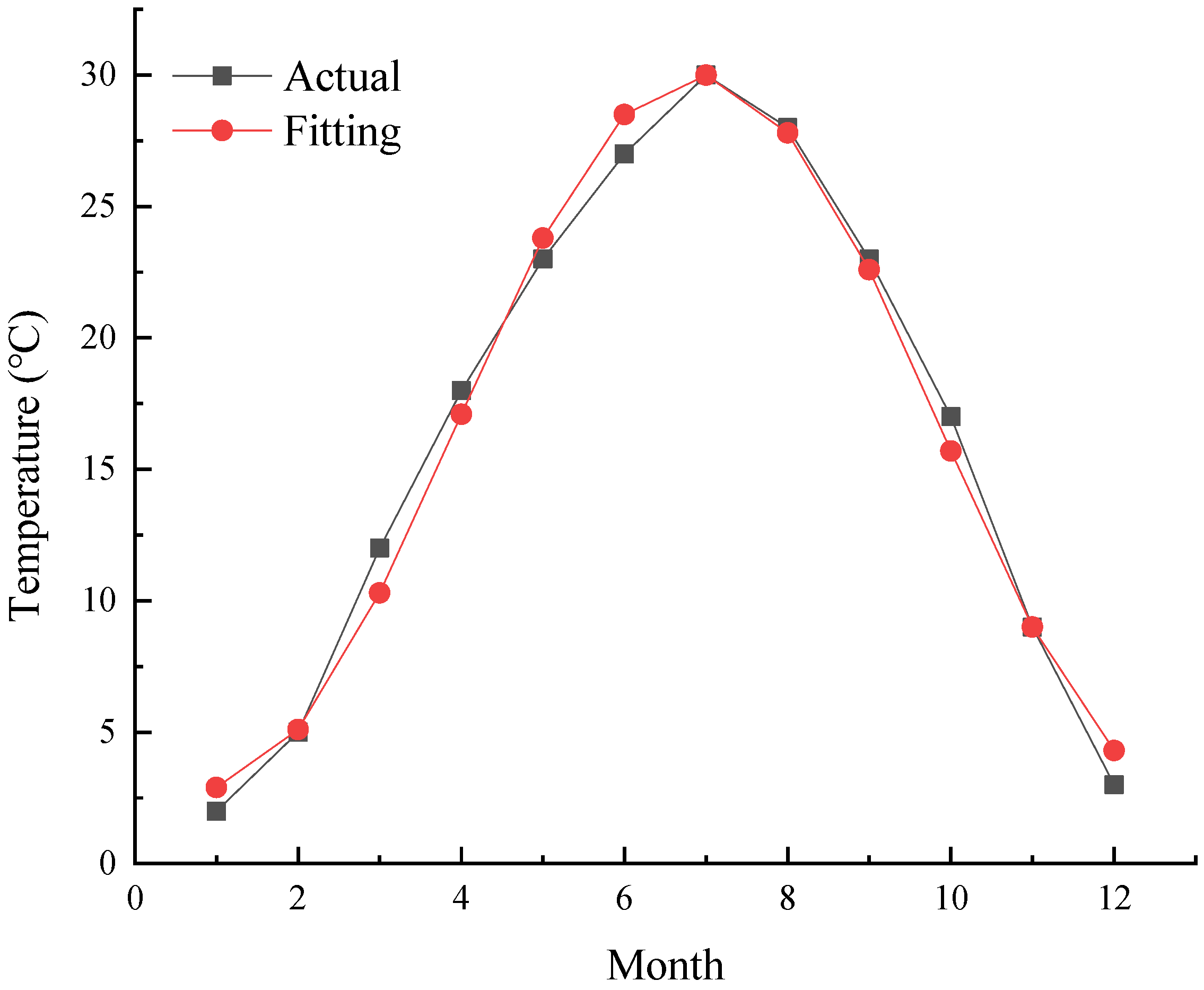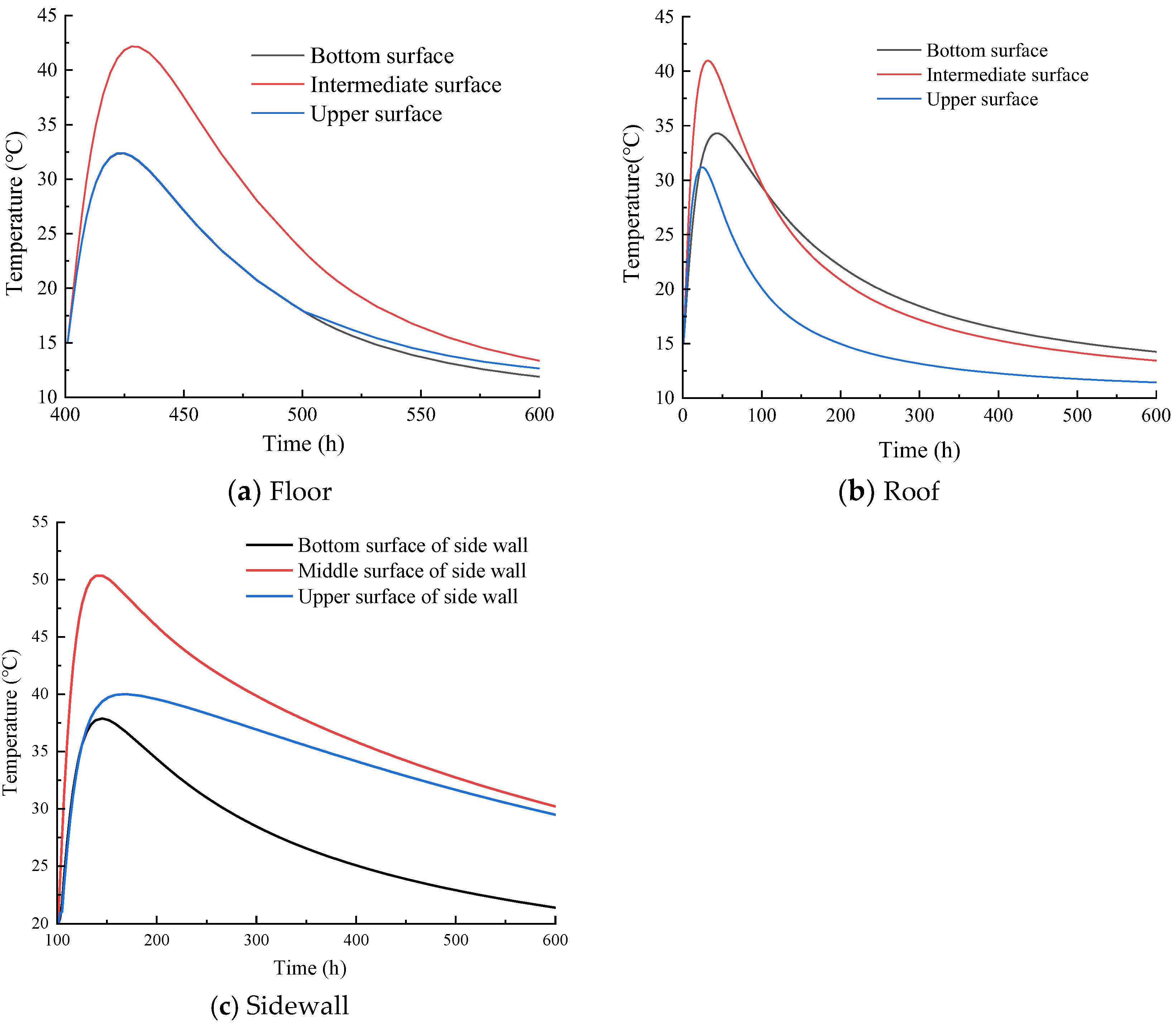Thermal-Mechanical Analysis of a Metro Station’s Concrete Structure
Abstract
:1. Introduction
2. Methods and Theories
2.1. Theory of Concrete Temperature Field Analysis
- (1)
- Initial condition of concrete structure: T(x, y, z, τ) = T0(x, y, z);
- (2)
- Concrete surface temperature is a function of time, i.e., T(x, y, z, τ) = Tτ;
- (3)
- The heat flux of the concrete surface is a known function of time, i.e.,
- (4)
- The surface heat flow of the concrete is proportional to the difference between the surface temperature of the concrete and the air temperature, i.e.,
- (5)
- The temperature and heat flow on the contact surface is continuous when the contact between different solids is under complete closure, i.e., T1 = T2,
2.2. Damaged Constitutive Relationship for Concrete
3. Calculation and Analysis
3.1. Engineering Background
3.2. FEM Model
3.3. Boundary Conditions and Construction Simulation
3.4. Calculation Results
3.4.1. Temperature Field
3.4.2. Stress Field
3.4.3. Damage Distribution
3.5. Analysis and Discussion
4. Conclusions
Author Contributions
Funding
Data Availability Statement
Conflicts of Interest
References
- Sun, D.; Zhao, Y.H.; Lu, Q.C. Vulnerability analysis of urban rail transit networks: A case study of Shanghai, China. Sustainability 2015, 7, 6919–6936. [Google Scholar] [CrossRef] [Green Version]
- Qi, F.; Wu, Y.X.; Zhang, W.J. Study on fiber concrete impermeability test and its application in metro station. Adv. Mater. Res. 2011, 261, 280–286. [Google Scholar] [CrossRef]
- Zhu, B.F. Key principles for temperature control of mass concrete. In Thermal Stresses and Temperature Control of Mass Concrete; Elsevier: Amsterdam, The Netherlands, 2014; pp. 469–478. [Google Scholar]
- Dong, Z.; Quan, W.; Ma, X.; Li, X.; Zhou, J. Asymptotic homogenization of effective thermal-elastic properties of concrete considering its three-dimensional mesostructure. Comput. Struct. 2023, 279, 106970. [Google Scholar] [CrossRef]
- Wang, Z.H.; Zhang, L.; Liu, Y.; Liu, Y.Z. Study on temperature control and crack prevention of high-performance slag concrete structure during construction. In Proceedings of the International 2010 Conference on Mechanic Automation and Control Engineering, Wuhan, China, 26–28 June 2010; pp. 1219–1223. [Google Scholar]
- Hariri-Ardebili, M.A.; Seyed-Kolbadi, S.M. Seismic cracking and instability of concrete dams: Smeared crack approach. Eng. Fail. Anal. 2015, 52, 45–60. [Google Scholar] [CrossRef]
- Ghasemi, M.; Zhang, C.; Khorshidi, H.; Zhu, L.; Hsiao, P. Seismic upgrading of existing RC frames with displacement-restraint cable bracing. Eng. Struct. 2023, 282, 115764. [Google Scholar] [CrossRef]
- Qing, W.; Ren, X.D.; Ballarini, R. A multifield model for early-age massive concrete structure: Hydration, damage, and creep. J. Eng. Mech. 2020, 146, 04020115. [Google Scholar]
- Wang, G.Q.; He, M.; Zhou, C.J.; Xie, W.; Liu, X.; Chen, J.; Liu, H.; Lei, B.; Zhang, M. Temperature and temperature stress analysis in mass concrete under cold environments of strong wind and large diurnal temperature range. Geofluids 2022, 2022, 3064754. [Google Scholar] [CrossRef]
- Xiao, X.; Zhang, H.; Li, Z.; Chen, F.; Rasulo, A. Effect of temperature on the fatigue life assessment of suspension bridge steel deck welds under dynamic vehicle loading. Math. Probl. Eng. 2022, 2022, 7034588. [Google Scholar] [CrossRef]
- Yang, B.G.; He, P.; Peng, G.Y.; Tong, L. Temperature-stress coupling mechanism analysis of one-time pouring mass concrete. Therm. Sci. 2019, 23, 231. [Google Scholar] [CrossRef] [Green Version]
- Al-Saleh, S.A.; Al-Zaid, R.Z. Effects of drying conditions admixtures and specimen size on shrinkage strains. Cem. Concr. Res. 2004, 36, 1985–1991. [Google Scholar] [CrossRef]
- Zhang, W.; Kang, S.; Huang, Y.; Liu, X. Behavior of reinforced concrete beams without stirrups and strengthened with basalt fiber–reinforced polymer sheets. J. Compos. Constr. 2023, 27, 4023007. [Google Scholar] [CrossRef]
- Wu, Y.; Luna, R. Numerical implementation of temperature and creep in mass concrete. Finite Elem. Anal. Des. 2001, 37, 97–106. [Google Scholar] [CrossRef]
- Lan, C.; Lee, M.S.; Seo, T.S. Crack control design due to drying shrinkage in restrained reinforced concrete wall. Struct. Des. Tall Spec. Build. 2013, 22, 1047–1061. [Google Scholar]
- Kovler, K. Testing system for determining the mechanical behavior of early age concrete under restrained and free uniaxial shrinkage. Mater. Struct. 1994, 27, 324–330. [Google Scholar] [CrossRef]
- Lee, J.; Fenves, G.L. Plastic-damage model for cyclic loading of concrete structures. J. Eng. Mech. ASCE 1998, 124, 892–900. [Google Scholar] [CrossRef]
- Zhang, Z.; Liang, G.; Niu, Q.; Wang, F.; Chen, J.; Zhao, B.; Ke, L. A Wiener degradation process with drift-based approach of determining target reliability index of concrete structures. Qual. Reliab. Eng. Int. 2022, 38, 3710–3725. [Google Scholar] [CrossRef]
- Ma, Z.Y.; Dang, F.N.; Li, Y.L.; Cheng, Y.X. Influence of geostress field on dynamic mechanical behavior of intact rock. Arab. J. Geosci. 2021, 14, 78. [Google Scholar] [CrossRef]
- Li, Z.Y.; Ma, Z.Y.; Zhao, B.; Li, D.F.; Jiao, K. Fully Coupled Thermal-mechanical Analysis of Concrete Gravity Arch Dam. In Proceedings of the 8th International Conference on Hydraulic and Civil Engineering (ICHCE): Deep Space Intelligent Development and Utilization Forum, Xi’an, China, 25–27 November 2022; Volume 2022, pp. 856–861. [Google Scholar]
- Dassault Systems Simulia Corp. Abaqus 6.14 Help Documentation; Simulia: Johnston, RI, USA, 2014. [Google Scholar]
- Liu, H.; Chen, Z.; Liu, Y.; Chen, Y.; Du, Y.; Zhou, F. Interfacial debonding detection for CFST structures using an ultrasonic phased array: Application to the Shenzhen SEG building. Mech. Syst. Signal Process. 2023, 192, 110214. [Google Scholar] [CrossRef]
- Zhu, B.F. Precooling and surface cooling of mass concrete. In Thermal Stresses and Temperature Control of Mass Concrete; Elsevier: Amsterdam, The Netherlands, 2014; pp. 401–408. [Google Scholar]
- Zhou, Y.C.; Bai, L.; Yang, S.Y.; Chen, G.T. Simulation Analysis of Mass Concrete Temperature Field. Procedia Earth Planet. Sci. 2012, 5, 5–12. [Google Scholar]
- Wang, M.; Yang, X.; Wang, W. Establishing a 3D aggregates database from X-ray CT scans of bulk concrete. Constr. Build. Mater. 2022, 315, 125740. [Google Scholar] [CrossRef]
- Liu, N.F.; Li, N.; Li, G.F.; Song, Z.P.; Wang, S.J. Method for Evaluating the Equivalent Thermal Conductivity of a Freezing Rock Mass Containing Systematic Fractures. Rock Mech. Rock Eng. 2022, 55, 7333–7355. [Google Scholar] [CrossRef]
- Liu, N.F.; Li, N.; Wang, S.J.; Li, G.F.; Song, Z.P. A fully coupled thermo-hydro-mechanical model for fractured rock masses in cold regions. Cold Reg. Sci. Technol. 2022, 205, 103707. [Google Scholar] [CrossRef]
- Ma, Z.Y.; Dang, F.N.; Liao, H.J. Numerical study of the dynamic compaction of gravel soil ground using the discrete element method. Granul. Matter 2014, 16, 881–889. [Google Scholar] [CrossRef]









| Parameters | Concrete (C35) | Foundation Soil |
|---|---|---|
| Specific heat (kJ/kg∙°C) | 0.98 | 0.8 |
| Thermal conductivity (kJ/(m∙h∙°C)) | 9.8 | 7 |
| Coefficient of thermal expansion | 8 × 10−6 | 1 × 10−6 |
| Density (kg/m3) | 2400 | 1800 |
| Initial temperature (°C) | 20 | 15 |
| Poisson’s ratio | 0.2 | 0.2 |
Disclaimer/Publisher’s Note: The statements, opinions and data contained in all publications are solely those of the individual author(s) and contributor(s) and not of MDPI and/or the editor(s). MDPI and/or the editor(s) disclaim responsibility for any injury to people or property resulting from any ideas, methods, instructions or products referred to in the content. |
© 2023 by the authors. Licensee MDPI, Basel, Switzerland. This article is an open access article distributed under the terms and conditions of the Creative Commons Attribution (CC BY) license (https://creativecommons.org/licenses/by/4.0/).
Share and Cite
Ma, Z.; Li, W.; Li, Z.; Ruan, X.; Jiao, K. Thermal-Mechanical Analysis of a Metro Station’s Concrete Structure. Processes 2023, 11, 1124. https://doi.org/10.3390/pr11041124
Ma Z, Li W, Li Z, Ruan X, Jiao K. Thermal-Mechanical Analysis of a Metro Station’s Concrete Structure. Processes. 2023; 11(4):1124. https://doi.org/10.3390/pr11041124
Chicago/Turabian StyleMa, Zongyuan, Wei Li, Zhaoyu Li, Xuefei Ruan, and Kai Jiao. 2023. "Thermal-Mechanical Analysis of a Metro Station’s Concrete Structure" Processes 11, no. 4: 1124. https://doi.org/10.3390/pr11041124





